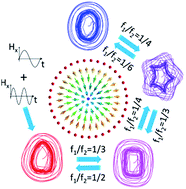Dual-frequency microwave-driven resonant excitations of skyrmions in nanoscale magnets
Abstract
Since the first prediction of their existence in magnetic materials, skyrmions have been intensively investigated both theoretically and experimentally. However, it remains a challenge to manipulate skyrmions and to understand their dynamics. We study nonlinear dynamics of coupled skyrmions in Co/Ru/Co nanodisks by micromagnetic simulations and show that resonant excitation can be controlled in nanoscale magnets by a dual-frequency microwave field. Two coupled resonant modes, clockwise (CW) and counterclockwise (CCW) rotation modes, are found. Polygon-like resonant excitation is observed and modulated from triangle-like to heptagon-like dynamics by a microwave field with a commensurate frequency ratio. The quasiperiodic behavior of the excitation is related to an incommensurate ratio. We also present numerical solutions of the extended Thiele’s equation for skyrmions and obtain a good agreement between the solutions and the micromagnetic simulation results. This work contributes to the understanding of skyrmion dynamics and supplies a new route to manipulating skyrmions in nanoscale magnets using resonant excitation.


 Please wait while we load your content...
Please wait while we load your content...